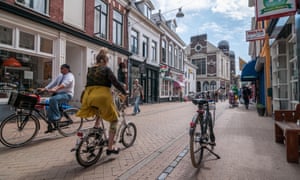Actus Monde
From free bikes to steering wheel spikes: how to boost urban cycling | The Guardian
Car-free days, filtered permeability and lower speed limits are just some of the ways that cities around the world are trying to encourage cycling.
Cycling in London is on the rise – up 56% on some routes since 2014. The construction a few years ago of a number of protected cycle lanes in the city centre undoubtedly helped drive this change, but there are additional ways to boost the number of people on bikes. We explore 10 ideas below – please contribute yours in the comments section.
Free bikes
If the benefits of cycling – both economic and environmental – outweigh the cost of bikes overall, then why not simply give bikes away?
Like most cycling initiatives, this idea can be traced to the Netherlands, where the anarchist group Provo distributed 10,000 white bikes to the city of Amsterdam in the 1960s.
These were free for everyone to use, on the basis that “per kilometre [one bike] would cost the municipality only 10% of what it contributed to public transport per person per kilometre”. The authorities hadn’t made the same calculations, however, and the white bikes were quickly removed – or were stolen.
Variations have since cropped up round the world. InAdelaide, free daily hire bikes are available to visitors and residents as part of the Australian city’s Smart Move strategy. Birmingham in the UK ran a scheme last year where residents of poorer postcodes could apply for a free bike if they agreed to ride it. Meanwhile, in Gothenburg, Sweden, the government is giving free bikes to commuters who promise to drive less.
Filtered permeability
In 1977, Groningen – a small city in the northern Netherlands – underwent a rapid transformation. Provisional signs and barriers were covertly erected to direct cars out of the city centre until they were gradually, over several months, confined to areas outside it.
By selectively reducing the number of city streets available to vehicles, journeys that were once relatively easy by car became arduous and convoluted. Residents chose to cycle instead of drive, even when heading to a big furniture and homewares store such as Ikea – whose specially designed cargo bikes are popular with locals.
Source : From free bikes to steering wheel spikes: how to boost urban cycling | Cities | The Guardian
